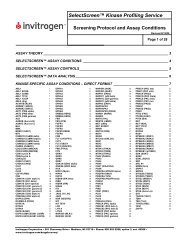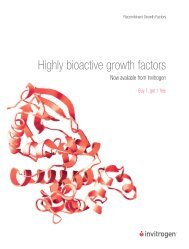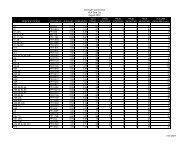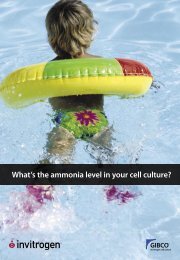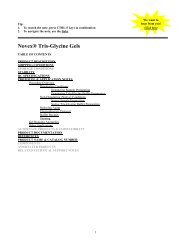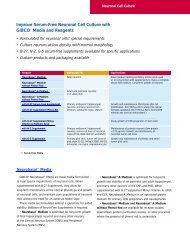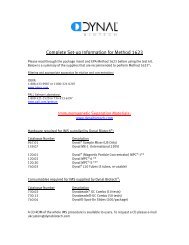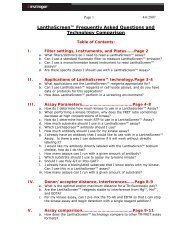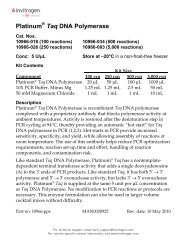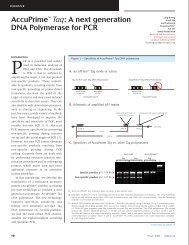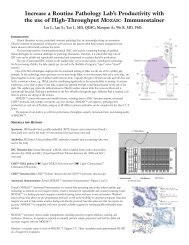TRIzol Reagent - Invitrogen
TRIzol Reagent - Invitrogen
TRIzol Reagent - Invitrogen
Create successful ePaper yourself
Turn your PDF publications into a flip-book with our unique Google optimized e-Paper software.
Sample was not fully homogenized.<br />
Tissues not IMMEDIATELY processed or frozen after removal from animal.<br />
Tissues were not completely disrupted; if a centrifugation is done prior to adding chloroform, there should be a white<br />
mucus-like pellet. If there is a tan-colored precipitate, this is indicative that not all of the cells have been lysed.<br />
If a mortar and pestle was used to powder the tissue, RNA and DNA may stick nonspecifically to the mortar and pestle. It<br />
may be better to use a glass homogenizer and teflon pestle; add <strong>TRIzol</strong> to the homogenizer, then add frozen tissue and<br />
homogenize.<br />
RNA stored after isolation at -20°C instead of -70°C.<br />
Tissue culture cells were disrupted by trypsin.<br />
Homogenizing for too long and too continuously in a small volume (e.g., 1 ml) may cause heating of the sample; this may<br />
result in degradation of the RNA in the tissue. Samples should be cooled during homogenization, and homogenization<br />
should be done in on-off cycles (as opposed to continuously).<br />
OD reading may vary due to solution the sample is stored in AND what it was diluted in prior to quantitation. Wilfinger,<br />
et. al., in (1997) BioTechniques 22.3, 478 reports that increases in ionic strength may significantly reduce nucleic acid<br />
absorbance, thereby affecting quantitative determinations based on A260.<br />
DNA Contamination in RNA Prep<br />
(back to Table of Contents)<br />
(back to Protocol and Application Notes)<br />
(back to RNA Isolation)<br />
A portion of the interphase was removed with the aqueous phase after the initial separation.<br />
An insufficient amount of <strong>TRIzol</strong> was added to the sample. In general, 1 ml of <strong>TRIzol</strong> should be used for every 0.05 g of<br />
tissue or every 10 cm 2 dish.<br />
Original sample had traces of other organic material to begin with (ethanol, DMSO, etc).<br />
RNA should be treated with Amplification Grade DNase I prior to RT-PCR.<br />
There were insolubles after the first homogenization that were not removed by centrifugation before chloroform<br />
extraction.<br />
Poor A260/A280 Ratios For RNA (< 1.65)<br />
(back to Table of Contents)<br />
(back to Protocol and Application Notes)<br />
(back to RNA Isolation)<br />
Sample homogenized in too small a volume of <strong>TRIzol</strong>.<br />
Samples not stored at room temperature for 5 minutes after homogenization<br />
Final RNA pellet was not fully dissolved. This may be the case if the RNA pellet was overdried (if the pellet is clear and<br />
not white, this indicates overdrying). To get the pellet to dissolve completely, heat to 55-60°C for 10-15 minutes and<br />
repeatedly pipet.<br />
There may be phenol contamination. This may occur if samples were centrifuged at room temperature instead of 4°C;<br />
phenol is more soluble in the aqueous phase at room temperature. If absorbance is seen at 270 nm (phenol), sample can be<br />
ethanol precipitated to remove residual phenol.<br />
Guanidine absorbs around 240 nm. Phenol has two peaks: one around 275 nm, the other is broad and covers from below<br />
220 to around 240 nm. If a very large peak is observed in that range, it is recommended to precipitate and wash again. It is<br />
also recommended to prevent this to do the phase separation after addition of chloroform at 4°C.<br />
Residual chloroform; reprecipitate.<br />
In some samples dissolved in water, the ratio may be low due to the acidity of the water or the low ion content in the<br />
water. The ratios may go up if the sample is dissolved in TE and the spec is zeroed with TE. (or 1-3 mM Na2PO4, pH<br />
~8.0). [See Wilfinger (1997) BioTechniques 22.3, 474]. The molar extinction coefficient of the nucleotides is given at<br />
neutral pH (see Maniatis), suggesting that the absorbance at 260 nm would be highest at neutral pH.<br />
If A280 is >0.5, the reading is out of the linear range; try making a dilution such that the A280 is below 0.5.<br />
Yellowish-Brown or Pinkish Colored Aqueous Phase<br />
(back to Table of Contents)<br />
(back to Protocol and Application Notes)<br />
(back to RNA Isolation)<br />
15



